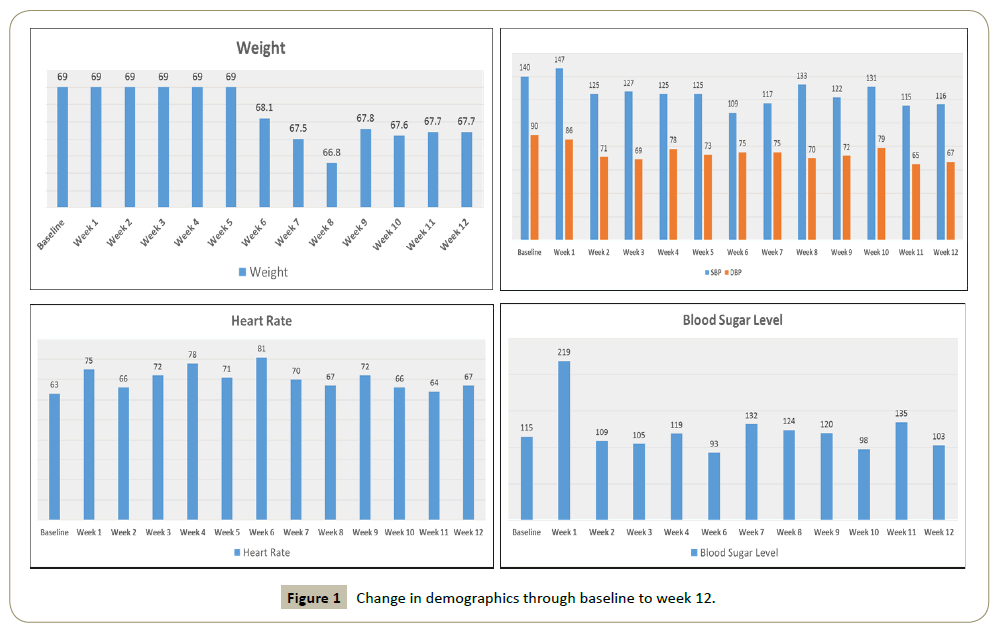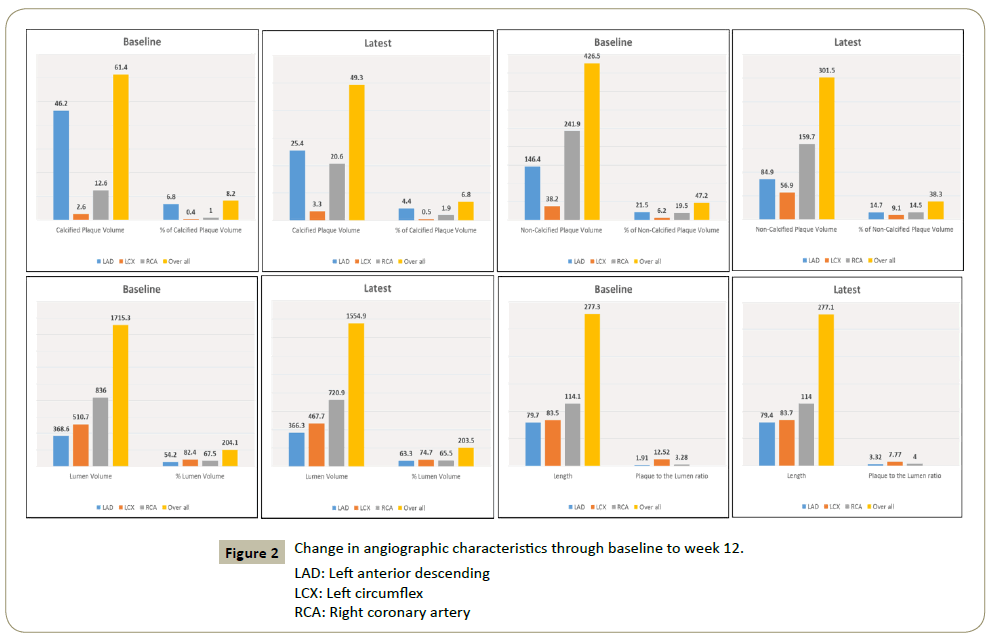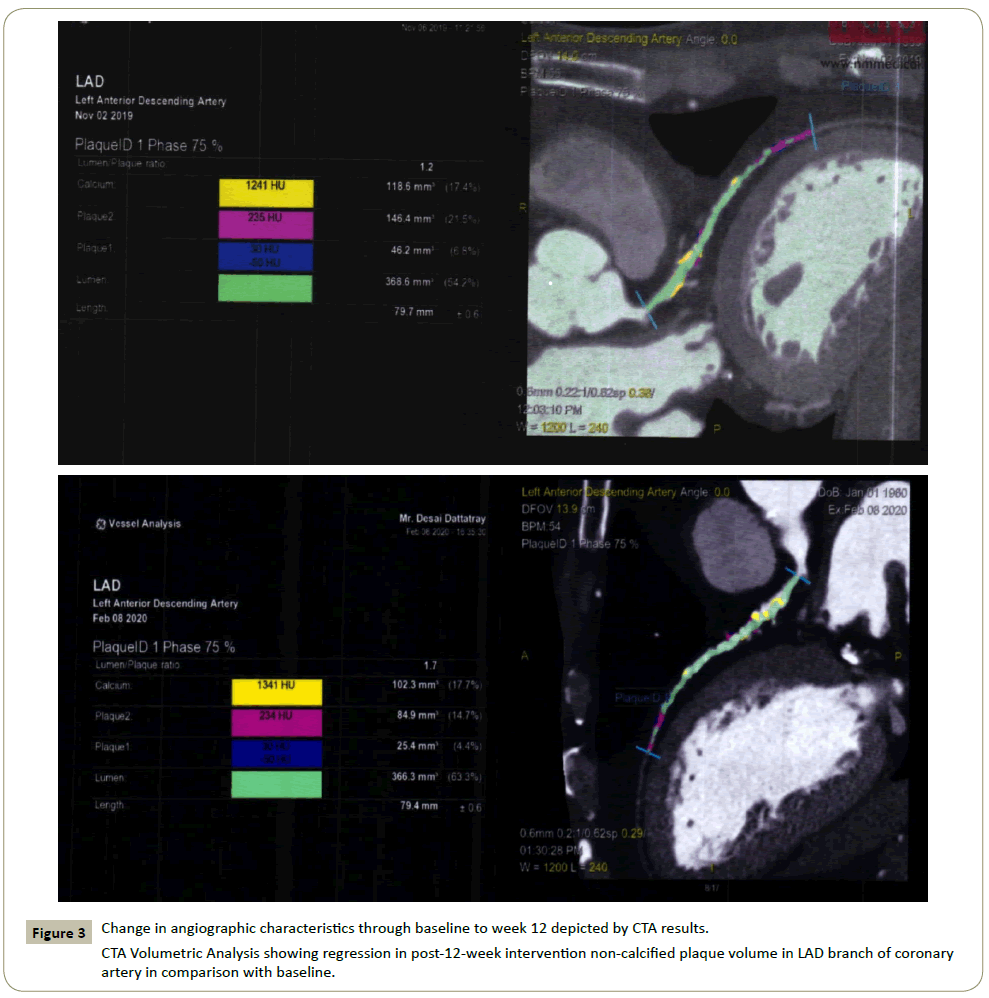Keywords
Atheroma; Cardiovascular disease; Coronary artery disease;
Plaque volume; Reverse diet
Introduction
Coronary artery disease (CAD) is the major cause of cardiovascular
disease (CVD) deaths, followed by stroke and heart failure. CVD
accounts for approximately 800,000 deaths in the United States,
while, CAD is the leading cause of morbidity related to CVD in
both men and women. The development of atherosclerotic
lesions in coronary arteries is central to the pathogenesis of CAD
and its progression depends upon various environmental and genetic risk factors, amongst, obesity, diabetes, hypertension,
and dyslipidaemia are the greatest risk factors [1-3].
Unhealthy dietary patterns including excessive intake of sodium
and processed foods; added sugars; unhealthy fats; and low
intake of fruit and vegetables, whole grains, fibres, legumes,
fish, and nuts along with overweight and obesity, stress, alcohol
consumption, smoking found increase the prevalence of CVD.
The Global Burden of Disease study also considered an unhealthy diet as a major factor behind CVD and its risk factors [4-6].
Hence, the prevention of CVD through lifestyle modifications
has become a public health priority [5]. Indeed, a large amount
of scientific evidence supporting the hypothesis that nutritional
modification might prevent CVD deaths, could even reverse the
remodelling and risk factors of CVD such as overweight/obesity,
hypertension, diabetes, or dyslipidaemia [2,7,8].
Therefore, the identification and classification of such dietary
patterns have become a priority. Indeed, the international
development and nutrition community trying to draw attention
to the development of such food systems. However, studies on
the interplay between diet and CVD/CAD are scarce especially in
low and middle-income countries [5]. The current single patient
experiment attempted to evaluate the relationship between
controlled diets along with standard medication and CAD
outcomes [9,10].
Materials and Methods
A 69-year-old male, with a known history of diabetes since 10-12
years had a complaint of occasional postprandial angina when
investigated with cardiac stress testing was diagnosed with
ischemic heart disease. Angiography on 19 Oct 2019 suggested
triple vessel disease (TVD) with 80-90% narrowing in all three
epicardial branches of the coronary artery. The patient has a BMI
of 22.3 kg/m2 (height: 176 cm and weight: 69 Kg). At baseline
patient's systolic blood pressure (SBP) was 140 mm/Hg, diastolic
blood pressure (DBP) was 90 mm/Hg, heart rate was 63 pulse/
min, and blood sugar level was 115 mg/dl. Informed consent was
obtained from the patient before the intervention on 19 Dec
2019.
Research design
The study involves a single patient assessment where the patient
acted as his control. The study was performed in two phases: The
baseline phase and the intervention phase.
Baseline phase: The duration before the intervention, when all
the baseline parameters were noted.
Intervention phase: The intervention phase was of 12 weeks,
where, the patient was put on the reverse diet. Patients were
suggested for daily walk and exercise (less aerobic). During
this phase patient’s daily diet, weight, SBP, and DBP before
and after the walk were monitored. Characterization and
quantification of atherosclerotic plaque as calcified fibrotic
and lipid core was done with help of 128 slice CCTA (cardiac CT
angiography) keeping resting HR below 70/min and breath hold
for 15 sec [11]. Non-ionic contrast was given during procedure.
These measurements were carried out before intervention on
2 Nov 2019 and after intervention on 8 Feb 2020. During the
entire study, along with the diet intervention, the patient was
also prescribed with standard medications including Ecosprin
(Aspirin), Clopilet (Clopidogrel), Met XL (Metoprolol), Tonact TG
(Atorvastatin+Fenofibrate), TenglynM (Metformin+Teneligliptin),
Metride (Glimepride+Metformin), and Ismo (Isosorbide-5-
mononitrate).
Computed tomography angiography (CTA)
CTA was done after IV injection of non-ionic contrast using
electrocardiogram (ECG) gating. Post-procedure the data was
collected with dedicated software and images and interpreted
as maximum intensity projections (MIP), multiplanar reformation
or reconstruction (MPR), curved MPR, and volume-rendering
technique (VRT) reformations.
Study intervention
The patient received a reverse diet kit, which is a scientifically
designed diet box contained pre-portion ready to cook food products
to fulfil daily requirements of breakfast, lunch, dinner, soup, and
early morning diet. The diet is proposed to have anti-inflammatory
and anti-oxidant properties that help reverse CAD progression,
improve vessel health, reduce plaque, and improve blood flow. The
nutrition content of the daily reverse diet is given in Table 1. The
monthly reverse diet kit contained the following products:
| Nutrition Factor |
Content |
| Calories |
1000 Kcal |
| Carbohydrates (Low insulin provoking and low glycaemic index carbohydrates) |
40% of total calories |
| Proteins (Moderate protein) |
20 % of total calories |
| Fats |
40% of total calories |
| Vitamin C |
1 g per day |
| Vitamin E |
Fortified |
| Potassium |
4700 mg |
| Omega 3 Fatty Acid |
Quantity sufficient |
| Low sodium |
Quantity sufficient |
| Garlic |
Quantity sufficient |
| Ginger |
Quantity sufficient |
Table 1: Nutrition content of the daily reverse diet.
1. Madhavprash: 5 g twice/ day (Early morning and evening)
2. Breakfast options:
a) Cardiac tea- 2 tea bags (56 tea bags/month)
b) Muthiya mix- 40 gm per packet (8 packets/month)
c) Soy dhokla mix- 40 gm per packet (12 packets/month)
d) Rajma flour dosa- 40 gm per packet (8 packets/month)
3. Main meal options: (For Lunch and Dinner):
a) Atta mix- 30 gm per packet (56 packets/month)
b) Lentil daal mix- 15 gm per packet (56 packets/month)
c) Herbs masala mix- 10 gm per packet (28 packets/month)
d) Chutney mix- 10 gm per packet (28 packets/month)
4. Evening snacks option:
a) Nuts mix chiwda- 30 gm per packet (28 packets/month)
b) Tamarind soup mix- 15 gm per packet (28 packets/month)
The monthly diet plan of the patient is shown in Table 2. The
reverse diet kit contained day to day food ingredients that are
easily available in the Indian climate hence no adverse events are
expected. However, vomiting, loose motions, hyperacidity may
encounter in case of allergy to any of the food ingredients.
Time/
Menu |
Monday |
Tuesday |
Wednesday |
Thursday |
Friday |
Saturday |
Sunday |
| Early morning |
1 tsp of Madhavprash |
| |
Boiled egg whites |
| Breakfast (8 am) |
1 Cup cardiac tea |
| |
Muthiya mix
(5-6 small Steam Balls) |
Soy dhokla mix (3-4 Medium pcs) |
2 small Rajma Flour Dosa |
Soy dhokla mix (3-4 Medium pcs) |
Muthiya mix
(5-6 small Steam Balls) |
Soy dhokla mix (3-4 Medium pcs) |
2 small Rajma Flour Dosa |
| |
2 tsp green chutney |
| Mid-morning (11 am) |
1 medium fruit |
| |
With lunch and dinner 1 tsp of chutney |
| Lunch (1 pm) |
1 bowl salad + pc of lemon |
| |
2 small fulka |
| |
1 bowl vegetable |
| |
1 bowl lentil daal |
| |
Grilled or steam 3-4 small pc chicken/fish |
| Mid-evening (4.30 pm) |
1 cup cardiac tea |
| |
1 cup nut mix chiwda+ 1tsp Madhavprash |
| Evening (6.30 pm) |
1 bowl tamarind soup |
| Dinner (8 pm) |
1 bowl salad + pc of lemon |
| |
2 small fulka |
| |
1 bowl vegetable |
| |
1 bowl lentil daal |
Tsp: Tea spoon
Table 2: Monthly diet plan of the patient.
Outcome measurement
Following the outcome, parameters were recorded: Weight, SBP,
DBP, heart rate, and blood sugar level measured at baseline, and
the end of every week during the 12 weeks of the intervention
period. Calcium score, calcium volume, % change in calcium
volume, calcified plaque volume and % change in calcified
plaque volume, non-calcified plaque volume and % change
in non-calcified plaque volume, lumen volume and % change
in lumen volume, a plaque to the lumen ratio, change and %
change in total atheroma volume in the left anterior descending
artery (LAD), right coronary artery (RCA), left circumflex artery
(LCX), and overall in the body measured at baseline and end of
the intervention phase. Standard medications used during the intervention and after the end of the intervention were also
recorded.
Results
At the end of week 12, the patient's weight was reduced by 1.3
kg, SBP and DBP were reduced by 24 and 23 mm/Hg respectively, and blood sugar was reduced by 12 mg/dl. The overall calcified
and non-calcified plaque volume, lumen volume, and atheroma
plaque volume was found reduced at the end of 12 weeks
of intervention (Figures 1, 2 and Table 3). The CTA results
are depicted in Figure 3. Additionally, after the intervention,
the requirement of the standard medications of the patient was reduced considerably and prescribed. Only with Tenglyn
(Metformin+Teneligliptin), and Metride (Glimepride+Metformin).
Figure 1: Change in demographics through baseline to week 12.
Figure 2: Change in angiographic characteristics through baseline to week 12.
LAD: Left anterior descending
LCX: Left circumflex
RCA: Right coronary artery
| Artery |
Before
(mm3) |
After
(mm3) |
Change
(mm3) |
| Left anterior descending |
146.4 |
84.9 |
61.5 |
| Left circumflex |
38.2 |
56.9 |
-18.7 |
| Right coronary artery |
241.9 |
159.7 |
82.2 |
| Overall atheroma plaque volume |
426.5 |
301.5 |
125 |
Table 3: Change in total atheroma volume from baseline to week 12
Figure 3: Change in angiographic characteristics through baseline to week 12 depicted by CTA results.
CTA Volumetric Analysis showing regression in post-12-week intervention non-calcified plaque volume in LAD branch of coronary artery in comparison with baseline.
Discussion
A recent study in Jordanians evaluating the effect of dietary
patterns on the risk of cardiovascular heart diseases (CHD) found
that a healthy and high fibre diet lowers the odds of CHD by
40%. The healthy and high fibre Jordanian diet contains fruits,
vegetables, fish, and olive oil which is found similar to other
healthy dietary patterns. Various studies from the USA and
Europe also found that a healthy diet lowers the risk of CHD by 20% to 30% [12-15] in the interventional study with the
Mediterranean diet showed a 38% reduction in CVD compared to
control. The Mediterranean diet which contains olive oil, fruits,
vegetables, nuts, legumes, and fish is found healthy in reducing
the risk of CVD in various other studies [16]. This experimental
evidence served as a scientific basis for the preventive activity of
a healthy diet in CVD [17,18].
The trans-fats and saturated fats found an increased risk of
CHD, while polyunsaturated fats are found protective. Dietary
sodium is associated with elevated blood pressure, while
dietary potassium lowers the risk of hypertension and stroke. Various fruits and vegetables have a protective action against
hypertension, CHD and stroke. Hence, the composite diets
(such as dietary approaches to stop hypertension (DASH) diets,
Mediterranean diet, and ‘prudent’ diet) found reduced the risk of
hypertension and CHD and also secondarily prevent CVD [19,20].
The reverse diet intervention in the current study is composed of
low carbohydrates, a rich source of omega 3 fatty acids, vitamins,
and minerals. Carbohydrates help reduce weight, inflammation,
triglycerides, and high-density lipoproteins and thereby improve
vessel health. The daily intake of omega 3 fatty acids reduces the
formation of inflammatory products, and vitamins and minerals
have antioxidant property which neutralizes pro-inflammatory
products and free radicals thereby holds inflammation. Vitamin C
raises immunity; it also increases collagen synthesis and protects
blood vessels. Pomegranate and garlic are a rich source of nitric
oxide and have proven antioxidant property which helps dilate
the blood vessels, lowers blood pressure, clotting, and plaque
formation. The anti-oxidant capacity of the reverse diet is 64,000
oxidative radical absorption capacity (ORAC) units per day which
is far higher than any conventional food serves (3000-4000
ORAC units per day). Adhering to such diets will help to reduce
endothelial dysfunction and cessation of atherosclerotic plaque
progression and ultimately primary and secondary prevention of
CVD. Similarly, in the current study of CAD patients, at end of
the intervention atheroma formation, blood pressure, weight,
overall calcified and non-calcified plaque volume, and overall
the odds of CAD, found reduced. Additionally, with the help of
the study therapy the dependence on standard medications to
manage CAD was reduced by 50% approximately.
Conclusion
CAD is an outcome of metabolic syndrome. Qualitative and
quantitative dietary correction plays an essential role avoid
inflammation and further progression of metabolic diseases
such as atherosclerosis. Medicines like statin can positively help
in atherosclerotic plaque regression but simultaneous dietary
correction may augment plaque progression. Therefore reverse
diet kit as stand-alone as well as add-on may be helpful in patients
with CAD. It is also known to impart maximum compliance as it
is available in pre-portioned and pre-packed form. This single
patient evidence suggests beneficial effect the reverse diet
intervention that may reduce the risk CAD.
References
- Benjami E, Blaha M, Chiuve S, Cushman M, Das, Deo R et al. (2017). Heart disease and stroke statistics—2017 update: a report from the American Heart Association. circulation, 135(10), e146-e603.
- Lacroix S, Cantin J, Nigam A. (2017). Contemporary issues regarding nutrition in cardiovascular rehabilitation. Annals of physical and rehabilitation medicine, 60(1), 36-42.
- Sayols-Baixeras S, Lluís-Ganella C, Lucas G, Elosua R. (2014). Pathogenesis of coronary artery disease: focus on genetic risk factors and identification of genetic variants. The application of clinical genetics, 7, 15.
- Abubakar II, Tillmann T, Banerjee A. (2015). Global, regional, and national age-sex specific all-cause and cause-specific mortality for 240 causes of death, 1990-2013: a systematic analysis for the Global Burden of Disease Study 2013. Lancet, 385(9963), 117-171.
- Anand SS, Hawkes C, De Souza RJ, Mente A, Dehghan M et al. (2015). Food consumption and its impact on cardiovascular disease: importance of solutions focused on the globalized food system: a report from the workshop convened by the World Heart Federation. Journal of the American College of Cardiology, 66(14), 1590-1614.
- Casas R, Castro-Barquero S, Estruch R, Sacanella E. (2018). Nutrition and cardiovascular health. International journal of molecular sciences, 19(12), 3988.
- O’Rourke K, VanderZanden A, Shepard D, Leach-Kemon K. (2015). Cardiovascular disease worldwide, 1990-2013. Jama, 314(18), 1905-1905.
- Mozaffarian D, Ludwig DS. (2010). Dietary guidelines in the 21st century—a time for food. Jama, 304(6), 681-682.
- Imamura F, Micha R, Khatibzadeh S, Fahimi S, Shi P, et al. (NutriCoDE. (2015). Dietary quality among men and women in 187 countries in 1990 and 2010: a systematic assessment. The lancet global health, 3(3), e132-e142.
- Micha R, Khatibzadeh S, Shi P, Fahimi S, Lim S (2014). Global, regional, and national consumption levels of dietary fats and oils in 1990 and 2010: a systematic analysis including 266 country-specific nutrition surveys. Bmj, 348.
- Conte E, Mushtaq S, Pontone G, Li Piani L, Ravagnani P, et al. (2020). Plaque quantification by coronary computed tomography angiography using intravascular ultrasound as a reference standard: a comparison between standard and last generation computed tomography scanners. European Heart Journal-Cardiovascular Imaging, 21(2), 191-201.
- Tayyem RF, Al-Shudifat AE, Johannessen A, Bawadi HA, AbuMweis SS, et al. (2018). Dietary patterns and the risk of coronary heart disease among Jordanians: a case–control study. Nutrition, Metabolism and Cardiovascular Diseases, 28(3), 262-269.
- Rodríguez-Monforte M, Flores-Mateo G, Sánchez E. (2015). Dietary patterns and CVD: a systematic review and meta-analysis of observational studies. British Journal of Nutrition, 114(9), 1341-1359.
- Zhang XY, Shu L, Si CJ, Yu XL, Liao D, et al. (2015). Dietary patterns, alcohol consumption and risk of coronary heart disease in adults: a meta-analysis. Nutrients, 7(8), 6582-6605.
- Hou L, Li F, Wang Y, Ou Z, Xu D, et al. (2015). Association between dietary patterns and coronary heart disease: a meta-analysis of prospective cohort studies. International journal of clinical and experimental medicine, 8(1), 781.
- Martinez-Gonzalez MA, Bes-Rastrollo M. (2014). Dietary patterns, Mediterranean diet, and cardiovascular disease. Current opinion in lipidology, 25(1), 20-26.
- Mozaffarian D. (2016). Dietary and policy priorities for cardiovascular disease, diabetes, and obesity: a comprehensive review. Circulation, 133(2), 187-225.
- Ros E, Martínez-González MA, Estruch R, Salas-Salvadó J, Fitó M, (2014). Mediterranean diet and cardiovascular health: Teachings of the PREDIMED study. Advances in nutrition, 5(3), 330S-336S
- Reddy KS, Katan MB. (2004). Diet, nutrition and the prevention of hypertension and cardiovascular diseases. Public health nutrition, 7(1a), 167-186.
- Yu E, Malik VS, Hu FB. (2018). Cardiovascular disease prevention by diet modification: JACC health promotion series. Journal of the American College of Cardiology, 72(8), 914-926.




